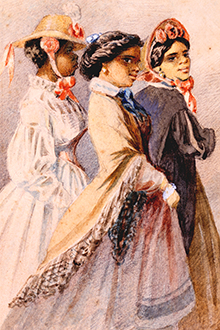Mystery of free women of color unraveled

Three Ladies of Color by Edouard Marquis is a sketch from life shortly after the Civil War in 1867. (Courtesy of the Collections of Louisiana State Museum)
The fable of the tragic mulatto is a familiar New Orleans story: A beautiful, young woman of color disdains marriage to a man of her own racial background. Her mother coerces her to form an illicit relationship with a wealthy white man who will support her in style.
The myth of the “lascivious, seductive quadroon” serves a purpose, presenting a stark contrast to the “respectability of white womanhood,” says Clark, author of The Strange History of the American Quadroon: Free Women of Color in the Revolutionary Atlantic World (University of North Carolina Press, 2013).
The myth, says Clark, was one of the things that “allowed the whole system of racial and sexual hierarchy to exist in the antebellum United States.”
The myth also supports the image of New Orleans as a “foreign space” of exotic temptations, which persists into the 21st century.
But as Clark has discovered through painstaking research into the rich archives of early New Orleans, especially its matrimonial and baptismal records from the 1730s to 1830s, the facts do not bear out the myth. In reality, “by the 1820s, a free woman of color of New Orleans ancestry was as likely to marry as a white woman.”
The complex stories of free women of color “should make us think about all kinds of other stories in American history that we"ve been comfortable with and haven"t asked questions about,” says Clark.
“It"s a good lesson in why it pays to go back and look at the archives. Archives are more likely to tell us what people were actually doing. Narrative accounts only tell us what people say people were doing.”
Clark will be giving a talk about her book on Sept. 17 at 6 p.m. at the Alumni House.
